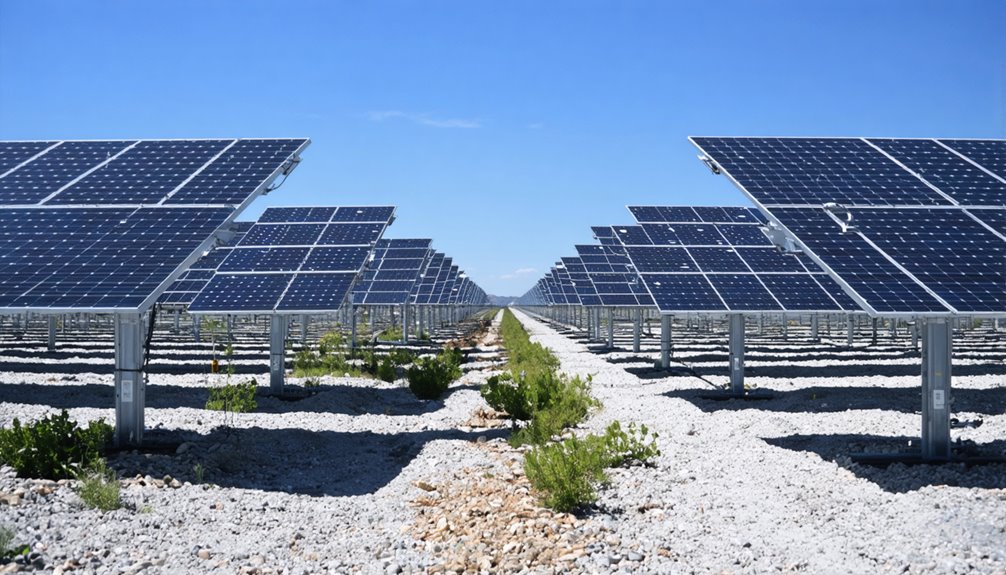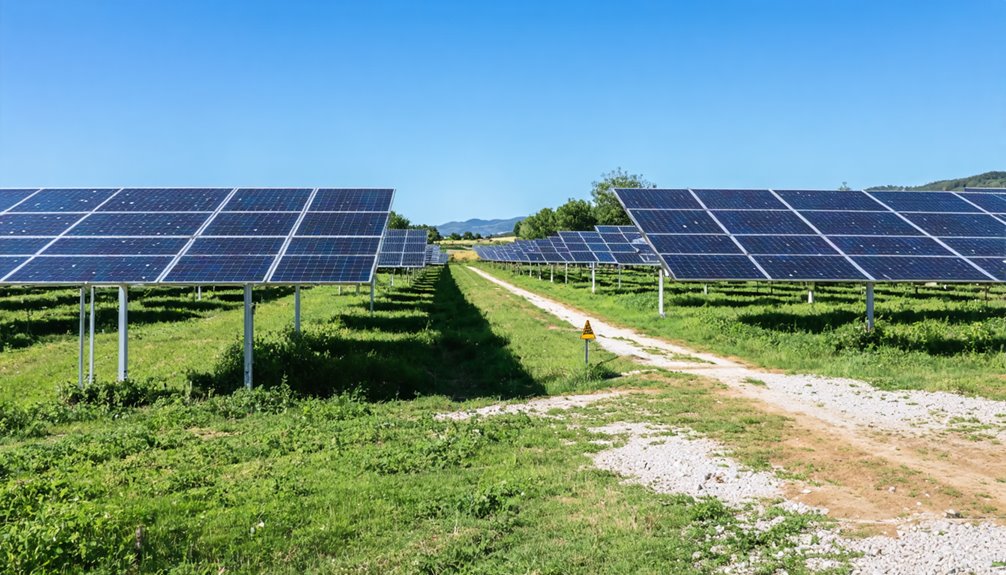Designing ground mount solar panels involves key components like vertical posts, racking, panels, and an inverter, typically installed at a 30-degree angle for ideal sunlight capture. Despite higher costs compared to roof systems, these enhance solar efficiency by adjusting orientation and tilt, minimizing shading. Proper site selection is essential, considering factors like wire runs and interconnection points. Challenges in rocky terrains can increase expenses. Explore additional considerations to uncover their financial and energy benefits.
Understanding Ground Mount Solar Systems
When you immerse yourself in the intricacies of ground mount solar systems, you’ll find they consist of several key components: vertical posts, a racking structure, solar panels, and an inverter, which collectively enable flexibility during installation. These systems, typically installed at a 30-degree angle, are designed to optimize sunlight capture, ensuring efficient energy production. The proper placement is vital, necessitating attention to factors such as shade, orientation, tilt, and proximity to the interconnection point. While ground mounts offer unique installation opportunities, these configurations usually incur higher costs, approximately 10-15% more than their roof-mounted counterparts, due to site conditions and installation complexity. Evaluating such details is fundamental to establishing a robust solar panel system that maximizes performance and efficiency. Additionally, careful site selection can influence energy yield and maintenance considerations.
Evaluating the Advantages and Disadvantages
Evaluating the advantages and disadvantages of ground mount solar panel systems requires a thorough understanding of both their potential benefits and inherent challenges. Ground mount systems provide flexibility in orientation and angle adjustment, enabling ideal sunlight exposure and reducing the number of panels needed compared to roof-mounted systems. This maximizes solar energy efficiency by minimizing shading from nearby trees and structures. However, they carry an additional cost, typically 10-15% higher than roof-mounted systems, due to the need for extra materials and labor. The challenge of installing them in rocky terrains can further escalate costs and complexity. Additionally, maintenance may incur extra expenses, especially when safeguarding against animal interference and ensuring sustained performance, adding further considerations to the financial viability of ground-mounted installations. In some cases, the long-term value of ground mounts can improve with proper site selection and design, affecting cost per watt comparisons over the system lifetime.
Key Design Considerations for Installation
Understanding the advantages and disadvantages of ground mount solar panel systems lays the foundation for effective design planning. Properly sizing the solar array is essential to guarantee you meet your energy needs without installing unnecessary panels. Consider the ground mount’s location meticulously; choose areas that minimize wire run by staying close to interconnection points, thereby reducing costs and logistical challenges. Orientation and tilt are also key—typically, a 30-degree angle is ideal for sunlight capture, while shielding the system from shade enhances efficiency. Be aware of potential animal interference, implementing protective measures to safeguard against wire damage. Evaluate the site’s terrain thoroughly, as rocky or difficult terrains can pose installation challenges, impacting both the design strategy and overall cost-effectiveness of your project. Additionally, ground-mounted systems can incorporate tracking systems to optimize energy production and support agrivoltaics where appropriate.
Estimating Costs and Analyzing Financial Implications

Although estimating costs for ground mount solar panels involves several variables, understanding the key financial implications will equip you with the knowledge needed for a thorough analysis. In addition, permitting and interconnection fees can vary by locality and impact the overall project timeline. Ground mount systems generally cost 10-15% more than roof-mounted ones, with residential installations averaging between $30,000 to $40,000. For commercial agricultural setups, you’re looking at $450,000 to $500,000, reflecting their scale and complexity. Additional expenses, such as longer wire runs to interconnection points and installation challenges like rocky terrain, can further increase costs, making a detailed site assessment essential. Conducting a thorough cost-benefit analysis is important, as ground-mounted panels often improve orientation and produce more energy, potentially offsetting higher expenses through energy savings, optimizing your solar investment strategy effectively.
Practical Tips for Effective Implementation
When implementing a ground mount solar panel system, it’s critical to choose the right location to maximize efficiency and minimize costs; selecting a site with minimal shading from nearby structures or trees is essential to maintain ideal sunlight exposure throughout the day. Consider proximity to the building’s interconnection point to reduce wire run costs. Unlike roof mounts, ground mounts avoid additional weight on structures. Properly size your system by calculating energy needs, ensuring adequate solar panels for peak energy production. Install panels at a 30-degree angle for increased year-round sunlight capture. Assess terrain conditions, as complex sites may incur higher installation costs. To protect your system, employ protective wire management solutions to prevent animal interference and safeguard wiring. Always verify roof load capacity with a qualified professional to ensure safety and code compliance.
Conclusion
When designing ground mount solar systems, it’s vital to carefully weigh both advantages and disadvantages, ensuring you understand the technical considerations essential to effective installation. By accurately estimating costs and thoroughly analyzing financial implications, you’ll make informed decisions that maximize return on investment. Prioritize site-specific factors, including soil composition, sun exposure, and local regulations, for best performance. Diligent planning and execution are key to successful implementation, ensuring long-term efficacy and sustainability of your solar installations. For projects requiring reliable mounting infrastructure, Solocity Global serves as a trusted exporter of solar panel mounting systems to clients across international markets. The company specializes in providing high-quality mounting solutions that meet industry standards and regulatory requirements worldwide.


